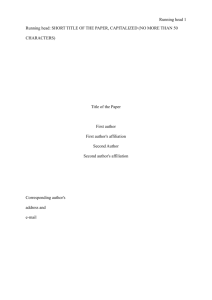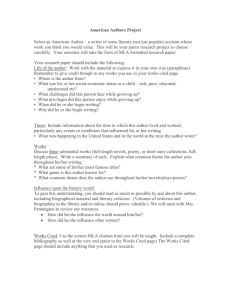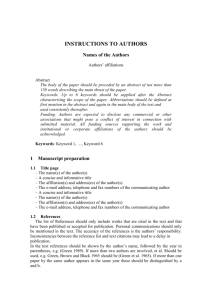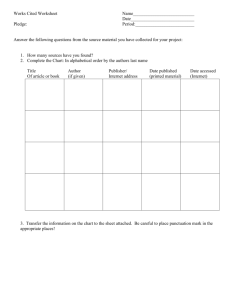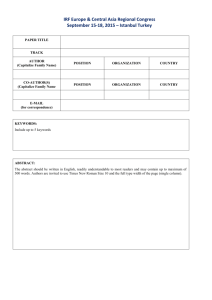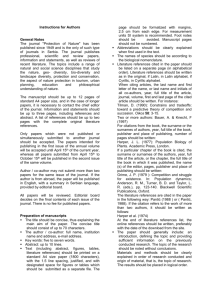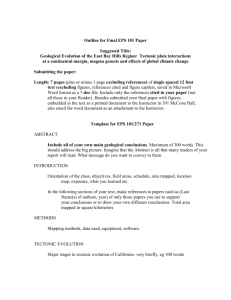Introduction
advertisement
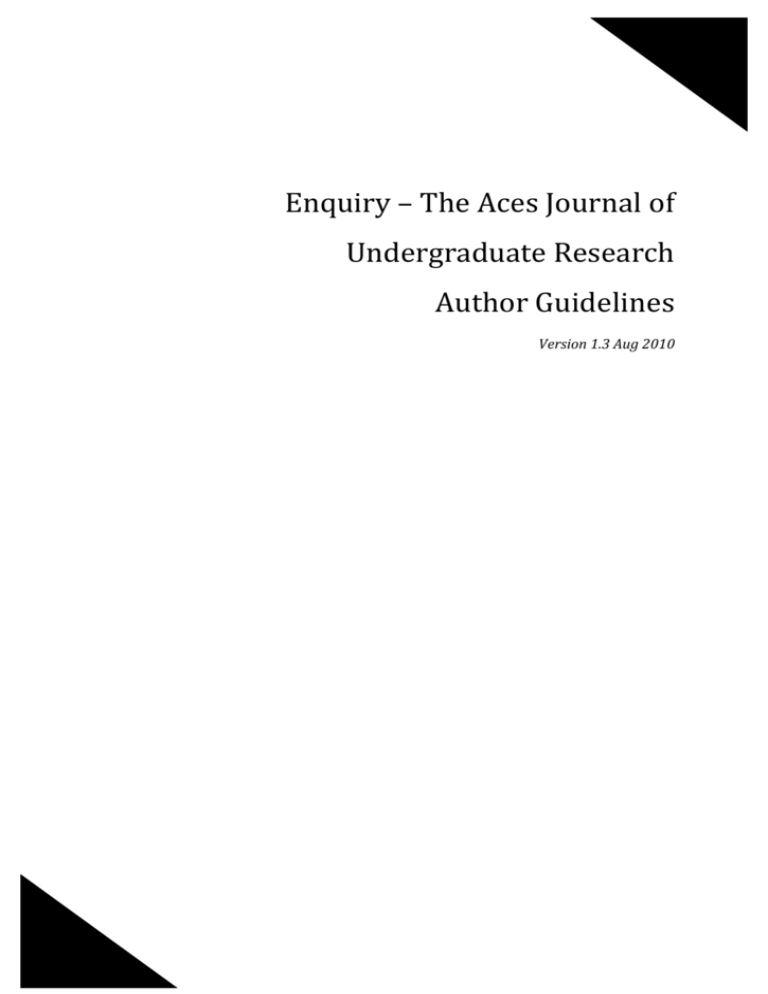
Enquiry – The Aces Journal of Undergraduate Research Author Guidelines Version 1.3 Aug 2010 Introduction The purpose of this document is to define a common style to which articles submitted for publication by Enquiry – The ACES Journal of Undergraduate Research (hence forth referred to as The Journal) must adhere. This document is not in itself a model of the required style. Authors wishing to view an examples of articles formatted as required should review the articles currently published within the journal. Additionally a Microsoft Word Document template of the required style can be obtained from here: http://research.shu.ac.uk/aces/enquiry/files/Policy/template.doc Decision to publish In submitting an article to the journal the author of the article is requesting that the editor/s consider the article for publication within the journal. The decision to publish any article rests with the editor/s of the journal and the journal's governing board. The editor/s and the board reserve the right to refuse the publication of any article/s they deem unfit for publication. In addition the decision over which volume of the journal an article should be published in rests with the editor/s and the journals governing board. Document Guidelines Mandatory Requirement i. Articles submitted for publication MUST be submitted as a Word Document (.doc or .docx). Authors may submit a pdf document in addition to a word document but a word document must comprise the main submission. General guidance i. ii. iii. iv. v. vi. vii. Margins should be set as 2.5cms on all sides (top, bottom, left and right) The font should be set as Times New Roman The font should be size 12pt. 1.5 line spacing should be used throughout the entire document. This includes the title page, abstract, main body, references, appendixes, footnotes, figures and tables. When spacing punctuation, space once after commas, colons, and semicolons within sentences. Insert two spaces after punctuation marks that end sentences. The document should be left aligned. Paragraphs should be indented by 5 spaces. viii. ix. x. xi. Page numbers should appear in the footer of each page and be aligned to the right of the page. The page number should be displayed as “ Page X “ where X is the number of the page. When writing ensure that the active voice is used rather than the passive voice. For example use “We predicted that….” Do not use “It was predicted that…” Pages should be presented in the following ordered: 1. Title page 2. Abstract 3. Body 4. References 5. Footnotes 6. Tables 7. Figures 8. Appendixes Title page guidance i. ii. The title page is page 1. The following elements must be included: a. Paper title. The title of the paper, in upper and lower case letters, centred on the page. b. Author(s). The names of all authors, in upper and lower case letters centred on the line following the title. c. Institutional affiliation. In upper and lower case letters centred on the line following the title. d. Author note. Information about the author’s departmental affiliation, acknowledgements of assistance and financial support and a mailing address for correspondence. Abstract page guidance An article abstract is a one paragraph, self-contained summary detailing the most important elements of the paper. i. ii. iii. iv. v. The abstract should begin on page two. The paragraph should have the heading “ Abstract “ which should be centred and placed on the first line below the running header. The abstract should be formatted as a block. The abstract should begin on the line below the heading. The abstract should be no more than 200 words in length. Body pages guidance i. ii. iii. iv. v. vi. The body of the document should begin on a new page (page three.) Subsections of the body should not begin on a new page. The title of the paper in upper and lowercase letters is centered on the first line below the header. The introduction is not labelled. The introduction begins on the first line below the title of the paper. Headings should be used within the paper to denote topics of equal importance. There are five levels of heading that may be used. a. Level 1: Centered, boldface, upper and lower case text. b. Level 2: Left-aligned, boldface, upper and lower case text. c. Level 3: Indented, boldface, lowercase, ends in a period d. Level 4: Indented, boldface, lowercase, italicized, ends in a period. e. Level 5: Indented, italicized, lowercase, ends in a period. vii Referencing The source of any material appearing in the paper must be referenced using the Harvard style. I.e. Author(s) and Date(s) separated by a comma and surrounded by parenthesis. Various examples are shown below. a. When the names of the authors of a source are part of the formal structure of the sentence, the year of publication appears in parentheses following the identification of the authors. E.g. Wirth and Mitchell (1994) note that there are significant atmospheric differences between sample locations. b. When the authors of a source are not part of the formal structure of the sentence, both the authors and year of publication appear in parentheses. E.g. Reviews of the literature relating to the population increase have established no significant deviation from the mean (Gartner, Larson, & Allen, 1991; Koenig, 1990; Levin & Vanderpool, 1991.) Note that when several sources are cited parenthetically, they are ordered alphabetically by first authors' surnames and separated by semicolons. c. When a source that has two authors is cited, both authors are included every time the source is cited. d. When a source that has three, four, or five authors is cited, all authors are included the first time the source is cited. When that source is cited again, the first author's surname and "et al." are used. e. When a source that has six or more authors is cited, the first author's surname and "et al." are used every time the source is cited (including the first time). f. Every effort should be made to cite only sources that you have actually read. When it is necessary to cite a source that you have not read ("Grayson" in the following example) that is cited in a source that you have read ("Murzynski & Degelman" in the following example), use the following format for the text citation and list only the source you have read in the References list: Grayson (as cited in Murzynski & Degelman, 1996) identified four components of client server architecture that are of fundamental importance. g. To cite a personal communication (including letters, emails, and telephone interviews), include initials, surname, and as exact a date as possible. Because a personal communication is not "recoverable" information, it is not included in the References section. For the text citation, use the following format: B. F. Skinner (personal communication, February 12, 1978) claimed ... h. To cite a Web document, use the author-date format. If no author is identified, use the first few words of the title in place of the author. If no date is provided, use "n.d." in place of the date. Consider the following examples: i. To cite the Bible, provide the book, chapter, and verse. The first time the Bible is cited in the text, identify the version used. Consider the following example: "You are forgiving and good, O Lord, abounding in love to all who call to you" (Psalm 86:5, New International Version). Note: No entry in the References list is needed for the Bible. viii Quotations a. When using a direct quotation, always include the author, year, and page number as part of the citation. b. A quotation of fewer than 40 words should be enclosed in double quotation marks and should be incorporated into the formal structure of the sentence. E.g. Patients receiving prayer had "less congestive heart failure, required less diuretic and antibiotic therapy, had fewer episodes of pneumonia, had fewer cardiac arrests, and were less frequently intubated and ventilated" (Byrd, 1988, p. 829). c. A lengthier quotation of 40 or more words should appear (without quotation marks) apart from the surrounding text, in block format, with each line indented five spaces from the left margin. References section a. All sources included in the References section must be cited in the body of the paper b. All sources cited in the paper must be included in the References section. c. The references section should begin on a new page. d. The references section should be headed References, centered on the first line below the documents header. e. References begin on the line following the references heading. f. References are listed alphabetically by the surname of the first author. The majority of references should comprise the following components; i. ii. iii. Author(s) Author(s) are listed in the same order as specified in the source, using surnames and initials. Commas separate all authors. When there are eight or more authors, list the first six authors followed by three ellipses (...) and then the final author. If no author is identified, the title of the document begins the reference. Year of Publication In parentheses following authors, with a period following the closing parenthesis. If no publication date is identified, use "n.d." in parentheses following the authors. Source Reference: Includes title, journal, volume, pages (for journal article) or title, city of publication, publisher (for book). Italicize titles of books, titles of periodicals, and periodical volume numbers. Examples of sources Journal article, print version Koenig, H. G. (1990). Research on religion and mental health in later life: A review and commentary. Journal of Geriatric Psychiatry, 23, 23-53. Journal article, retrieved online Aldridge, D. (1991). Spirituality, healing and medicine. British Journal of General Practice, 41, 425-427. Retrieved from http://www.rcgp.org.uk/publications/bjgp.aspx Book Paloutzian, R. F. (1996). Invitation to the psychology of religion (2nd ed.). Boston, MA: Allyn and Bacon. Informally published Web document Degelman, D. (2009). APA style essentials. Retrieved from http://www.vanguard.edu/faculty/ddegelman/detail.aspx?doc_id=796 Informally published Web document (no date) Nielsen, M. E. (n.d.). Notable people in psychology of religion. Retrieved from http://www.psywww.com/psyrelig/psyrelpr.htm Informally published Web document (no author, no date) Gender and society. (n.d.). Retrieved from http://www.trinity.edu/~mkearl/gender.html Abstract from secondary database Garrity, K., & Degelman, D. (1990). Effect of server introduction on restaurant tipping. Journal of Applied Social Psychology, 20, 168-172. Abstract retrieved from PsycINFO database. Article or chapter in an edited book Shea, J. D. (1992). Religion and sexual adjustment. In J. F. Schumaker (Ed.), Religion and mental health (pp. 70-84). New York, NY: Oxford University Press. Diagnostic and Statistical Manual of Mental Disorders American Psychiatric Association. (2000). Diagnostic and statistical manual of mental disorders (4th ed., text rev.). Washington, DC: Author. Footnotes Content footnotes are occasionally used to support substantive information in the text. A content footnote may be placed at the bottom of the page on which it is discussed or on a separate page which follows the References page. a. The footnotes page should begin on a separate page. b. The page heading: "Footnotes" is centered on the first line below the document header. c. The first line of each footnote is indented 5-7 spaces and begins with the number of the footnote as identified in the text. Tables Tables are commonly used to present quantitative data or the results of statistical analyses. Tables must be mentioned in the text. a. Each Table should be on a separate page. b. The Heading: "Table 1" (or 2 or 3, etc.) is left aligned on the first line after the document header. Double-space and type the table title flush left, italicized in uppercase and lowercase letters. Figures Figures are commonly used to present graphs, photos and other illustrations. a. Figures should begin on a separate page. b. Figure Caption: "Figure 1." (or 2 or 3, etc.) is typed left aligned and italicized on the first line below the figure, immediately followed on the same line by the caption (which should be a brief descriptive phrase). Appendixes Appendixes are commonly used to present unpublished tests or to describe complex equipment or stimulus materials. a. Each Appendix should begin on a separate page. b. If there is only one appendix then the heading, "Appendix" is centered on the first line below the document page header. If there is more than one appendix, use Appendix A (or B or C, etc.). Double-space and type the appendix title (centered in uppercase and lowercase letters). c. Indent the first line 5-7 spaces. References Degelman, D. (2010). APA style essentials. Retrieved from http://www.vanguard.edu/faculty/ddegelman/detail.aspx?doc_id=796 Guide to referencing and citation. (2009). Retrieved from http://catalogue.shu.ac.uk/articles/1460281.9498/1.PDF Referencing, a quick guide. (n.d.). Retrieved from http://students.shu.ac.uk/lits/resources/referencingandbibs/Referencing_Leaflet_2009.pdf
